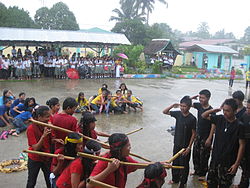Kabasalan Last updated July 20, 2025 Municipality in Zamboanga Sibugay, Philippines
Municipality in Zamboanga Peninsula, Philippines
Kabasalan , officially the Municipality of Kabasalan (Cebuano : Lungsod sa Kabasalan Chavacano : Municipalidad de Kabasalan ; Tagalog : Bayan ng Kabasalan municipality in the province of Zamboanga Sibugay , Philippines . According to the 2020 census, it has a population of 46,884 people. [ 5]
History The first inhabitants of the place are of Subanen origin. Kabasalan comes from the word basal , meaning to play the agung , a musical instrument which is a favorite pastime of the Subanon. It was during the old times that the whole peninsula was resonating with the sound of that instrument.
In 1956, Siay was established, as twenty-six barrios and sitios , including Barrio Siay which would be the seat of government in the newly created municipality, had been separated from Kabasalan, along with parts of Malangas . [ 6]
Kabasalan was greatly affected by Typhoon Tembin (2017) which most of the municipality where flooded. Schools were destroyed due to strong winds.
Geography Barangays Kabasalan is politically subdivided into 29 barangays . Each barangay consists of puroks while some have sitios .
Banker Buayan Cainglet Calapan Calubihan (F.L.Pena) Canacan (Bolo Battalion) Concepcion (Balungis) Diampak Dipala Gacbusan Goodyear Lacnapan Little Baguio Lumbayao Nazareth Palinta Peñaranda Poblacion Salipyasin (Riverside) Sanghanan Santa Cruz Sayao Shiolan Simbol Sininan Tamin Tampilisan Tigbangagan Timuay Danda (Mangahas) Climate Climate data for Kabasalan, Zamboanga Sibugay Month Jan Feb Mar Apr May Jun Jul Aug Sep Oct Nov Dec Year Mean daily maximum °C (°F) 31 31 32 31 30 29 29 29 29 29 30 30 30 Mean daily minimum °C (°F) 23 23 24 25 25 25 24 24 24 24 24 23 24 Average precipitation mm (inches) 61 55 75 81 145 189 189 197 162 181 115 70 1,520 Average rainy days 16.4 15.7 19.1 21.5 26.9 27.1 26.4 25.0 24.2 26.8 23.5 18.7 271.3 Source: Meteoblue [ 7]
Demographics Population census of Kabasalan Year ±% p.a. 1918 9,843 — 1939 15,882 +2.30% 1948 19,037 +2.03% 1960 19,920 +0.38% 1970 15,304 −2.60% 1975 19,175 +4.63% 1980 24,658 +5.16% 1990 32,323 +2.74% 1995 34,483 +1.22% 2000 37,619 +1.88% 2007 40,169 +0.91% 2010 41,421 +1.12% 2015 44,336 +1.30% 2020 46,884 +1.18% 2024 48,366 +0.75% Source: Philippine Statistics Authority [ 8] [ 9] [ 10] [ 11] [ 12]
Economy Poverty incidence of Kabasalan
Kabasalan and its neighboring towns is being served by Flash-FM 91.3 MHz and Countryside Cable Television, Inc.
References ↑ Municipality of Kabasalan | (DILG) ↑ "2015 Census of Population, Report No. 3 – Population, Land Area, and Population Density" (PDF) . Philippine Statistics Authority . Quezon City, Philippines. August 2016. ISSN 0117-1453 . Archived (PDF) from the original on May 25, 2021. Retrieved July 16, 2021 . ↑ "2024 Census of Population (POPCEN) Population Counts Declared Official by the President" . Philippine Statistics Authority. 17 July 2025. Retrieved 18 July 2025 . ↑ "PSA Releases the 2021 City and Municipal Level Poverty Estimates" . Philippine Statistics Authority. 2 April 2024. Retrieved 28 April 2024 . ↑ "2024 Census of Population (POPCEN) Population Counts Declared Official by the President" . Philippine Statistics Authority. 17 July 2025. Retrieved 18 July 2025 . ↑ "Executive Order No. 223, s. 1956" . Official Gazette (Philippines) . Government of the Philippines . December 28, 1956. Retrieved May 1, 2024 . ↑ "Kabasalan: Average Temperatures and Rainfall" . Meteoblue. Retrieved 1 May 2020 . ↑ "2024 Census of Population (POPCEN) Population Counts Declared Official by the President" . Philippine Statistics Authority. 17 July 2025. Retrieved 18 July 2025 . ↑ Census of Population (2015). "Region IX (Zamboanga Peninsula)" . Total Population by Province, City, Municipality and Barangay . Philippine Statistics Authority . Retrieved 20 June 2016 . ↑ Census of Population and Housing (2010). "Region IX (Zamboanga Peninsula)" (PDF) . Total Population by Province, City, Municipality and Barangay . National Statistics Office . Retrieved 29 June 2016 . ↑ Censuses of Population (1903–2007). "Region IX (Zamboanga Peninsula)" . Table 1. Population Enumerated in Various Censuses by Province/Highly Urbanized City: 1903 to 2007 National Statistics Office . ↑ "Province of" . Municipality Population Data . Local Water Utilities Administration Research Division. Retrieved 17 December 2016 . ↑ "Poverty incidence (PI):" . Philippine Statistics Authority. Retrieved December 28, 2020 . ↑ "Estimation of Local Poverty in the Philippines" (PDF) . Philippine Statistics Authority. 29 November 2005. ↑ "2003 City and Municipal Level Poverty Estimates" (PDF) . Philippine Statistics Authority. 23 March 2009. ↑ "City and Municipal Level Poverty Estimates; 2006 and 2009" (PDF) . Philippine Statistics Authority. 3 August 2012. ↑ "2012 Municipal and City Level Poverty Estimates" (PDF) . Philippine Statistics Authority. 31 May 2016. ↑ "Municipal and City Level Small Area Poverty Estimates; 2009, 2012 and 2015" . Philippine Statistics Authority. 10 July 2019. ↑ "PSA Releases the 2018 Municipal and City Level Poverty Estimates" . Philippine Statistics Authority. 15 December 2021. Retrieved 22 January 2022 . ↑ "PSA Releases the 2021 City and Municipal Level Poverty Estimates" . Philippine Statistics Authority. 2 April 2024. Retrieved 28 April 2024 . External links
Places adjacent to Kabasalan
This page is based on this
Wikipedia article Text is available under the
CC BY-SA 4.0 license; additional terms may apply.
Images, videos and audio are available under their respective licenses.





